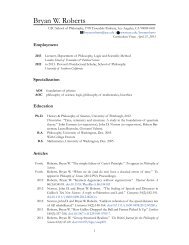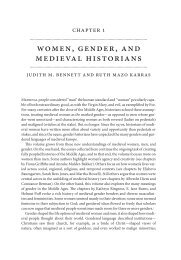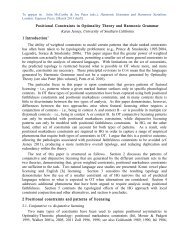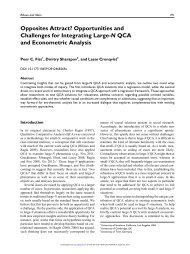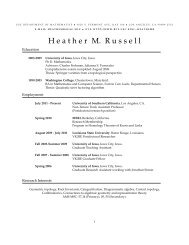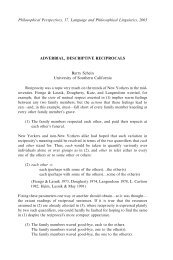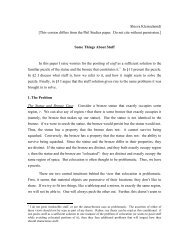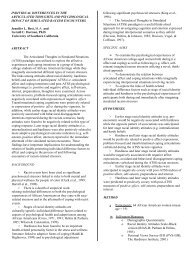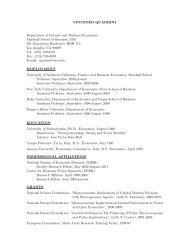The Tie that Binds: Peasant Marriages and Families in Late ... - Usc
The Tie that Binds: Peasant Marriages and Families in Late ... - Usc
The Tie that Binds: Peasant Marriages and Families in Late ... - Usc
You also want an ePaper? Increase the reach of your titles
YUMPU automatically turns print PDFs into web optimized ePapers that Google loves.
_louvnal oJIntevdiscipl<strong>in</strong>avy History, xv:~(Summer 1984), 111-129<br />
Judith M. Bennett<br />
<strong>The</strong> <strong>Tie</strong> <strong>that</strong> <strong>B<strong>in</strong>ds</strong>: <strong>Peasant</strong> <strong>Marriages</strong> <strong>and</strong><br />
<strong>Families</strong> <strong>in</strong> <strong>Late</strong> Medieval Engl<strong>and</strong><br />
On the last day<br />
of May 1319, Henry Kroyl senior attended his manorial court at<br />
Brigstock, Northamptonshire, <strong>and</strong> transferred a semi-virgate of<br />
l<strong>and</strong> to his son Henry Kroyl junior <strong>and</strong> his son's <strong>in</strong>tended wife,<br />
Agnes, the daughter of Robert Penifader. At the same session,<br />
the younger Kroyl endowed his bride with a small house, an<br />
adjo<strong>in</strong><strong>in</strong>g yard, <strong>and</strong> six rods of l<strong>and</strong>. Because the marriage <strong>that</strong><br />
lay beh<strong>in</strong>d these transactions united the children of two prom<strong>in</strong>ent<br />
villagers, the Brigstock records conta<strong>in</strong> nearly 2,000 references to<br />
the activities of Kroyl junior, Agnes Penifader, <strong>and</strong> the members<br />
of their immediate families. By us<strong>in</strong>g these legal proceed<strong>in</strong>gs to<br />
reconstruct the social spheres of the Kroyls <strong>and</strong> Penifaders, this<br />
article exam<strong>in</strong>es how this marital union changed the social networks<br />
of the pr<strong>in</strong>cipals, their parents, <strong>and</strong> their sibl<strong>in</strong>gs.'<br />
Medieval marriage was both a private matter <strong>and</strong> a public<br />
<strong>in</strong>stitution. Although it technically required only the couple's<br />
consent, it usually <strong>in</strong>volved the assistance of parents, the participation<br />
of neighbors, <strong>and</strong> the approval of adm<strong>in</strong>istrators. Marriage<br />
dis<strong>in</strong>tegrated old families by remov<strong>in</strong>g members to create a new<br />
family, but it also forged human l<strong>in</strong>ks <strong>that</strong> could strengthen social<br />
Judith M. Bennett is Assistant Professor of History at the Univers~ty of North Carol<strong>in</strong>a,<br />
Chapel Hill.<br />
<strong>The</strong> research for thls artlcle was funded by the Soclal Science Research Cout~cil <strong>and</strong><br />
a Jane Addams Fellowship of the American Associatiotl of University Women. An earlier<br />
verslon was presented at the New Engl<strong>and</strong> Medieval Conference (1980). <strong>The</strong> author wishes<br />
to thank Cynthia B. Herrup, Richard M. Smith, <strong>and</strong> Ilonald Reid for their helpful<br />
suggestions.<br />
ooz~-1g53/84/o101I 1-19 $o2.5o/o<br />
0 1984 by <strong>The</strong> Massachusetts Institute of Technology <strong>and</strong> the editors of <strong>The</strong>jouvnal 1,i<br />
Inteudiscipl<strong>in</strong>avy Histovy.<br />
I <strong>The</strong> 549 Brigstock court records from 1287 to 1348 are deposited with the Montagu<br />
Collection at the Northamptonshire Record Office <strong>in</strong> boxes X364A (files I through 24),<br />
X364B (files 25 through 38), <strong>and</strong> X365 (files 39 through 54), <strong>and</strong> <strong>in</strong> the Public Record<br />
Office, SC-2, 194165 (courts for 1298-1299). References to the Montagu materials are<br />
hereafter cited by NRO, file nurnber, <strong>and</strong> court date (day/monthlyear). <strong>The</strong> marriage<br />
settletnent is found 111 NRO, file 31: 31/5/1319. Space does not permit full citations of all<br />
Brigstock records or full descriptions of all aspects of the Kroyl <strong>and</strong> Penifader networks.<br />
Specific <strong>in</strong>formation is available from the author upon request.
I12 I<br />
JUDITH M. BENNETT<br />
ties with blood relations. As a result, the social extent <strong>and</strong> social<br />
limitations of this pivotal <strong>in</strong>stitution highlight the boundaries <strong>and</strong><br />
content of k<strong>in</strong>ship ties <strong>in</strong> late medieval Engl<strong>and</strong>.2<br />
Our ability to uncover these k<strong>in</strong>ship limitations <strong>and</strong> possibilities,<br />
however, has been <strong>in</strong>hibited not only by the difficulties<br />
of us<strong>in</strong>g legal records for social analyses, but also by our methodological<br />
approaches to the extant data. <strong>The</strong> aggregative techniques<br />
employed <strong>in</strong> recent studies of medieval rural life have been<br />
extraord<strong>in</strong>arily useful <strong>in</strong> recreat<strong>in</strong>g rural social structures, but they<br />
have usually obscured the familial elements <strong>that</strong> underp<strong>in</strong>ned<br />
those <strong>in</strong>stitutions. This historical perspective can be reversed by<br />
analyz<strong>in</strong>g the recorded <strong>in</strong>teractions of a selected group of people<br />
whose families have been reconstituted with unusual completeness.<br />
Such a narrow focus provides an ideal sett<strong>in</strong>g for network<br />
analysis. This system of chart<strong>in</strong>g <strong>and</strong> analyz<strong>in</strong>g <strong>in</strong>dividual contacts<br />
must necessarily be applied only to small groups because personal<br />
networks can quickly grow to unwieldy proportions. Thus, ill<br />
focus<strong>in</strong>g on the small set of <strong>in</strong>terrelated households <strong>that</strong> constituted<br />
the Kroyls <strong>and</strong> Penifaders of early fourteenth-century Brigstock,<br />
we can use network analysis to assess the importance of<br />
specific k<strong>in</strong> relationships <strong>in</strong> the medieval English co~ntryside.~<br />
In everyday speech, the term "network" is used loosely to<br />
describe the bonds <strong>that</strong> l<strong>in</strong>k an <strong>in</strong>dividual to others, but the an-<br />
2 For discussions of rnedieval marriage <strong>in</strong> both theory <strong>and</strong> practice, see Richard H.<br />
Helmholz, :Mnrviagr Lifi
PEASANT MARRIAGES I I13<br />
thropological use of social networks is much more precise <strong>and</strong><br />
ailalytical. Evolv<strong>in</strong>g ill response to the <strong>in</strong>adequate coverage of<br />
<strong>in</strong>formal social activities found <strong>in</strong> most structural-functionalist<br />
studies, network ailalysis exam<strong>in</strong>es how connectioils between <strong>in</strong>dividuals<br />
both reflect <strong>and</strong> affect behavior. Although - there is no<br />
formal theory of social networks, network analysis has, <strong>in</strong> the<br />
last few decades, produced ail elaborate set of analytical techniques<br />
<strong>and</strong> devices. <strong>The</strong> basic methodology is simple <strong>and</strong> straightforward;<br />
the researcher charts <strong>and</strong> analyzes the contacts <strong>that</strong> ail <strong>in</strong>dividual<br />
develops with members of his or her community. <strong>The</strong><br />
application of network analysis, however, is becomiilg <strong>in</strong>creas<strong>in</strong>gly<br />
sophisticated; the qualitative content <strong>and</strong> directional flow of<br />
contacts must be considered, as well as the extent of <strong>in</strong>dependent<br />
<strong>in</strong>teractions between two members of a third tlersoil's network.<br />
Network ailalysis provides a series of complex quantitative <strong>and</strong><br />
qualitative measurements <strong>that</strong> allow researchers to assess the importance<br />
of <strong>in</strong>formal social dynamics with<strong>in</strong> a given social environment.<br />
In the past two decades, imag<strong>in</strong>ative approaches to the data<br />
found <strong>in</strong> English village court rolls have sharply revised our<br />
uilderstaild<strong>in</strong>g of rural society <strong>and</strong> economy <strong>in</strong> the fourteenth <strong>and</strong><br />
fifteenth centuries. <strong>The</strong> Brigstock court was fairly typical. It met<br />
regularly every three weeks <strong>and</strong> coilsidered a broad sweep of<br />
matters relevant to village life; ii~heritances, assaults, trespasses,<br />
property disputes, persolla1 arguments, petty thefts, <strong>and</strong> l<strong>and</strong><br />
transfers were but a few of the items <strong>that</strong> normally fell under its<br />
jurisdiction. <strong>The</strong>se records primarily supply data on iloncoilflictive<br />
social <strong>in</strong>teractioils <strong>and</strong> relations, as most contacts <strong>in</strong> village<br />
courts <strong>in</strong>volved cooperation <strong>and</strong> exchange, rather than the <strong>in</strong>terpersonal<br />
disputes <strong>that</strong> we customarily associate with legal transactions."<br />
Like all historical records, court rolls cannot reflect the<br />
complete social worlds of their constituents, but the breadth <strong>and</strong><br />
depth of items brought before village courts made them a clear<strong>in</strong>g<br />
house for most community activities. Village courts are a w<strong>in</strong>dow,<br />
albeit circumscribed <strong>and</strong> cracked, through which historians<br />
4 Succ<strong>in</strong>ct descriptions of network analysis can be found <strong>in</strong> Mitchell, "Social Networks," <br />
Antzunl Review of Antllropology, I11 (1974), 279-299; James A. Barnes, Social Networks <br />
(Read<strong>in</strong>g, Mass., 1972). <br />
5 For exarnple, Kroyl junior's post-marital network <strong>in</strong>cluded only 24 conflicts it1 322 <br />
total contacts.
I14 1<br />
JUDITH M. BENNETT<br />
can observe the actions <strong>and</strong> dramas of rural life <strong>in</strong> medieval Engl<strong>and</strong>.<br />
<strong>The</strong> jurisdiction of Brigstock manor extended beyond the<br />
ma<strong>in</strong> village to <strong>in</strong>clude part of Stanion, an adjacent daughter<br />
settlement-located two <strong>and</strong> a half miles to the northwest.-<strong>The</strong><br />
lives of the residents of these two villages were <strong>in</strong>extricably <strong>in</strong>tertw<strong>in</strong>ed.<br />
<strong>The</strong> ma<strong>in</strong> Kroyl hold<strong>in</strong>gs lay <strong>in</strong> Brigstock, but Kroyl<br />
junior's particular <strong>in</strong>terests focused on Stanion. Similarly, the<br />
activities of the Penifaders spanned both villages, although their<br />
ma<strong>in</strong> hold<strong>in</strong>gs rested <strong>in</strong> Stanion. Shar<strong>in</strong>g common orig<strong>in</strong>s, common<br />
legal jurisdictions, <strong>and</strong> common ecclesiastical <strong>in</strong>stitutions,<br />
the <strong>in</strong>habitants of Brigstock <strong>and</strong> Stanion constantly exchanged<br />
both personnel <strong>and</strong> property. <strong>The</strong> clerk of Brigstock manor usually<br />
treated the two villages as one community. Because these<br />
villages lay <strong>in</strong> the heart of Rock<strong>in</strong>gham Forest, the manor was<br />
held by the crown as part of the ancient demesne <strong>and</strong> was surrounded<br />
by royal Its economy m<strong>in</strong>gled agriculture <strong>and</strong><br />
animal husb<strong>and</strong>ry with extensive exploitation of the adjacent<br />
parks <strong>and</strong> woodl<strong>and</strong>s. Dur<strong>in</strong>g the six decades prior to the arrival<br />
of the mid-fourteenth-century plague <strong>in</strong> the area, somewhere<br />
between 300 <strong>and</strong> 500 adult males resided <strong>in</strong> the Brigstock-Stanion<br />
community. Both economic <strong>and</strong> demographic prospects were<br />
falter<strong>in</strong>g, if not decl<strong>in</strong><strong>in</strong>g. As <strong>in</strong> most rural villages at this time,<br />
social life was dom<strong>in</strong>ated by a core group of long-resident male<br />
villagers who enjoyed both economic privilege (<strong>in</strong> hold<strong>in</strong>g semivirgates)<br />
<strong>and</strong> political power (by controll<strong>in</strong>g village office^).^<br />
6 <strong>The</strong> major work <strong>that</strong> began the historical reevaluation of court rolls is st111 the best<br />
<strong>in</strong>troduction to these sources. See J. Ambrose Raftis, Tenure <strong>and</strong> Mobility: Studies <strong>in</strong> the<br />
Social History ofthr Mediaeval English Village (Toronto, 1964). Other recent studies <strong>in</strong>clude<br />
idrtn, Wavboys: Tivo Hundvrd Yeaus <strong>in</strong> the Lijl. oj'atz Etzglish Mediaelial Village (Toronto,<br />
1974); Edw<strong>in</strong> Brezette DeW<strong>in</strong>dt, Laud aud People <strong>in</strong> Holyivell-cutn-Need<strong>in</strong>g~uoutIl (Toronto,<br />
1972).<br />
Smlth's extensive work with village courts led hirn to concur with the conclusion<br />
<strong>that</strong> court rolls faithfully reflect social relationships. See his “K<strong>in</strong> <strong>and</strong> Neighbors," 222-<br />
223. Obviously, historians, unlike anthropologists, cannot <strong>in</strong>terview their subjects to<br />
<strong>in</strong>quire <strong>in</strong>to the full soclal importance of various relationships. But, as Alan Macfarlane<br />
has argued, the abundant <strong>and</strong> accurate lnforrnation conta<strong>in</strong>ed <strong>in</strong> historical records about<br />
social relationships requires the developn~ent of historical tnethods for network analysis.<br />
See hls "History, Anthropology <strong>and</strong> the study of Communities," Social Histovy, V (1977),<br />
638-639.<br />
7 Bennett, "Gender," 43-82. Although it is ternpt<strong>in</strong>g to speculate <strong>that</strong> Kroyl junior's<br />
marriage to Agnes was calculated to smooth his entry <strong>in</strong>to Stanion life, no evidence
PEASANT MARRIAGES I I15<br />
<strong>The</strong> fathers of Agnes Penifader <strong>and</strong> Kroyl junior both belonged<br />
to this elite. Robert Penifader was a substantial l<strong>and</strong>holder<br />
<strong>in</strong> Stanion who served <strong>in</strong> several community offices. He <strong>and</strong><br />
Alice, his wife, produced eight known children (three sons <strong>and</strong><br />
five daughters). <strong>The</strong> careers of all three sons can be traced <strong>in</strong> the<br />
Brigstock records. <strong>The</strong> life histories of two daughters who only<br />
sporadically appeared <strong>in</strong> the courts cannot be fully reconstructed.<br />
Of the three other daughters, Cecilia never married, Crist<strong>in</strong>a<br />
married an outsider <strong>and</strong> emigrated (although she subsequently<br />
made l<strong>and</strong>-related appearances <strong>in</strong> the Brigstock court), <strong>and</strong> Agnes<br />
married Kroyl junior just one year after her father's death. Her<br />
husb<strong>and</strong>'s father, like her own, held substantial l<strong>and</strong>s <strong>and</strong> offices<br />
<strong>in</strong> the community, but his ma<strong>in</strong> hold<strong>in</strong>gs were located <strong>in</strong> Brigstock<br />
rather than <strong>in</strong> Stanion. Together with his wife, Agnes,<br />
Kroyl senior had four sons <strong>and</strong> no known daughters. William<br />
Kroyl ceased to appear <strong>in</strong> the courts <strong>in</strong> the early I~~OS, but the<br />
records show <strong>that</strong> his three brothers pursued important careers <strong>in</strong><br />
the community through the 1340s.~<br />
Fig. I sets forth the reconstructed genealogies of the Kroyls<br />
<strong>and</strong> Penifaders. <strong>The</strong> thirty-one people shown made 1,965 appearances<br />
<strong>in</strong> the extant records of the Brigstock courts between 1287<br />
<strong>and</strong> 1348. Personal networks have been constructed for each <strong>in</strong>dividual<br />
by list<strong>in</strong>g the persons with whom the subject <strong>in</strong>teracted<br />
<strong>and</strong> by count<strong>in</strong>g the number of exchanges. <strong>The</strong> content of these<br />
transactions has been divided <strong>in</strong>to six qualitative categories <strong>that</strong><br />
collectively encompass all possible transactions. <strong>The</strong>se categories<br />
are based upon whether the network subject <strong>in</strong>teracted with another<br />
person by (I) receiv<strong>in</strong>g assistance, (2)giv<strong>in</strong>g assistance, (3)<br />
act<strong>in</strong>g jo<strong>in</strong>tly, (4) receiv<strong>in</strong>g l<strong>and</strong>, (5) giv<strong>in</strong>g l<strong>and</strong>, or (6) engag<strong>in</strong>g<br />
<strong>in</strong> a di~pute.~<br />
supports this hypothesis. As a general rule, <strong>in</strong>terpersonal relationships totally ignored the<br />
physical boundary between Stanion <strong>and</strong> Brigstock. Geographical proximity was found to<br />
be an irrelevant factor <strong>in</strong> expla<strong>in</strong><strong>in</strong>g patterns of <strong>in</strong>teraction between the Penifaders <strong>and</strong><br />
Kroyls.<br />
8 <strong>The</strong> lost histories of Emma <strong>and</strong> Alice Penifader probably reflect untraced marriages<br />
rather than early death or emigration. Because women usually dropped their natal surnames<br />
upon marriage, they cannot be traced if their marriage records are lost. As a result,<br />
the potential social importance of the aff<strong>in</strong>e connections created by such marriages also<br />
cannot be exam<strong>in</strong>ed.<br />
9 Giv<strong>in</strong>g <strong>and</strong> receiv<strong>in</strong>g assistance usually took the form of personal pledg<strong>in</strong>g (guarantee<strong>in</strong>g<br />
the court-<strong>in</strong>curred obligations of another) or esso<strong>in</strong><strong>in</strong>g (excus<strong>in</strong>g those absent from<br />
court). Jo<strong>in</strong>t activity <strong>in</strong>cludes all <strong>in</strong>stances <strong>in</strong> which two persons acted together; two men
<strong>The</strong>se personal networks have been constructed completely<br />
from court entries <strong>and</strong> therefore reflect only those exchanges <strong>that</strong><br />
prompted legal attention. By the nature of the craft, medieval<br />
historians must rely upon archival evidence <strong>and</strong> can neither observe<br />
their subjects nor <strong>in</strong>quire <strong>in</strong>to the importance of certa<strong>in</strong><br />
relationships or contacts. With<strong>in</strong> the boundaries of this limitation,<br />
the records of medieval village courts are particularly f<strong>in</strong>e guides<br />
to the social worlds of their constituents. <strong>The</strong> courts met frequently<br />
<strong>and</strong> regularly, almost everyone attended their sessions,<br />
<strong>and</strong> the items considered ranged over a broad field of social,<br />
economic, <strong>and</strong> political matters. Every social <strong>in</strong>teraction did not<br />
merit a court notation, but <strong>in</strong>fluential social ties undoubtedly<br />
found their diluted reflection <strong>in</strong> the court records; when a man<br />
needed a personal pledge to back up a legal obligation, he turned<br />
not to a stranger, but to a friend. <strong>The</strong> daily associations of these<br />
people <strong>in</strong> the homes, fields, <strong>and</strong> lanes of their villages cannot be<br />
retrieved, but the transactions <strong>that</strong> they recorded <strong>in</strong> their triweekly<br />
community court are fair <strong>in</strong>dicators of their most important social<br />
relationships.<br />
Prior to the marriage of 1319, the social worlds of the Kroyls<br />
<strong>and</strong> Penifaders were discrete. Despite their mutual prom<strong>in</strong>ence <strong>in</strong><br />
community life <strong>and</strong> their large personal networks, Robert Penifader<br />
<strong>and</strong> Kroyl senior never <strong>in</strong>teracted with each other <strong>in</strong> court<br />
before the marriage of their children. Nor did the members of<br />
the seco11d generation of each family associate before the marriage.<br />
After the summer of I 3 19, however, this situation changed dramatically,<br />
but these changes varied accord<strong>in</strong>g to both family position<br />
<strong>and</strong> gender. lo<br />
who together pledged for a third man were counted as act<strong>in</strong>g jo<strong>in</strong>tly. L<strong>and</strong> transactions<br />
<strong>in</strong>clude both leases <strong>and</strong> outright transfers. <strong>The</strong> dispute category <strong>in</strong>cludes all controversies<br />
<strong>that</strong> arose between villagers-sl<strong>and</strong>ers, attacks, trespasses, unpaid debts, <strong>and</strong> thefts. Debt<br />
agreements rarely appear <strong>in</strong> the Brigstock courts <strong>and</strong> do not merit a separate category.<br />
<strong>The</strong> one debt contract recorded (when John Hirdman loaned Kroyl junior <strong>and</strong> his wife 10<br />
shill<strong>in</strong>gs <strong>in</strong> 1339) was counted <strong>in</strong> ths "assistance received" column. Court citations have<br />
not been automatically translated <strong>in</strong>to <strong>in</strong>teractions. A dispute <strong>that</strong> lasted for several <strong>in</strong>onths<br />
<strong>and</strong> generated numerous court entries has been counted as a s<strong>in</strong>gle <strong>in</strong>teraction regardless<br />
of the actual number of citations. Because personal pledges, however. could <strong>and</strong> did<br />
change over ti<strong>in</strong>e, each pledg<strong>in</strong>g relationship has been registered as a new <strong>in</strong>teraction even<br />
if it <strong>in</strong>volved the same people <strong>and</strong> problem.<br />
ro Robert Penifader's network i~lcluded 97 people with whom he had 211 contacts.<br />
Although he died one year before the marriage of his daughter Agnes, his three decades
I18 1<br />
JUDITIH &I. BENNETT<br />
Kroyl junior's social world was radically altered by his marriage.<br />
His limited premarital social contacts were strongly centered<br />
on his father, but, after marriage, contacts with his father<br />
sharply decl<strong>in</strong>ed as his network greu7 to <strong>in</strong>clude a much more<br />
diverse collection of cognate, aff<strong>in</strong>e, <strong>and</strong> nonfa~nilial associations.<br />
His premarital network <strong>in</strong>cluded thirty <strong>in</strong>teractions with twenty<br />
people, <strong>and</strong> he <strong>in</strong>teracted more than once with only three <strong>in</strong>dividuals-his<br />
father (n<strong>in</strong>e contacts) <strong>and</strong> two persons to who111 he<br />
was not related (two contacts each). His only multiplex relationship<br />
(<strong>in</strong>volv<strong>in</strong>g more than one type of contact) was with his father,<br />
<strong>and</strong> this paternal <strong>in</strong>fluence was re<strong>in</strong>forced by the overlap of personnel<br />
<strong>in</strong> the networks of father <strong>and</strong> son. Clearly, the younger<br />
Kroyl's early years <strong>in</strong> the Brigstock community were supervised<br />
<strong>and</strong> shaped by his father's assistance <strong>and</strong> <strong>in</strong>fluence.ll<br />
of activity <strong>in</strong>cluded only one contact with a Kroyl. 1x1 1292, he was pledged by a Matthew<br />
Kroyl, whose relationship to the Kroyls here considered is unknown (NKO, file 3: 1o/7/<br />
1292). Whatever Matthew's tie to the other Kroyls might have been, this s<strong>in</strong>gle contact<br />
is <strong>in</strong>significant <strong>in</strong> view of the size of Robert Penifader's social network. Kroyl senior's<br />
network <strong>in</strong>cluded 182 contacts with 103 people. He livcd for a decade after the marriage<br />
of his son to Agnes, but he never <strong>in</strong>teracted with the Penifadcrs (aside iron1 his participatioii<br />
<strong>in</strong> the rriarriagc settlement <strong>and</strong> <strong>in</strong> Agnes' endowment).<br />
Just a few months prior to the marriage agreement, Kroyl junior pledged for Alice<br />
Penifadcr (who would become his mother-<strong>in</strong>-law) <strong>and</strong> for Richard Power (the husb<strong>and</strong><br />
of his f~iture wife's sister). NIIO, file 31. 4/1/1319. 0ct.urr<strong>in</strong>g <strong>in</strong> such close proximity to<br />
the marriage, these <strong>in</strong>teractions were probably prompted by the knowledge of a future<br />
rclationship. <strong>The</strong> decision of Kro)-l junior <strong>and</strong> Agnes to wed necessarily required soille<br />
social <strong>in</strong>teraction betwccn them or their families. But. because the coiirt records reveal<br />
only m<strong>in</strong>imal prcrnarical exchanges betwccn these families, we can assume <strong>that</strong> the social<br />
dynamics <strong>that</strong> pfeceded the marriage were neither frequent nor <strong>in</strong>tense.<br />
I I 'T'he term "cogiiate family" <strong>in</strong>cludes all membcrs of a subject's natal family (parents<br />
<strong>and</strong> sibl<strong>in</strong>gs) as well as all membcrs of a subjcct's personal marital family (spouse <strong>and</strong><br />
children). In addition, descendants (gr<strong>and</strong>children, nieces, etc.) <strong>and</strong> ascendants (gr<strong>and</strong>parents,<br />
uncles, ctc.) of these farrnlies are <strong>in</strong>cluded. 'T'he complementary term "aff<strong>in</strong>e family"<br />
designates all persons to whom the subject was <strong>in</strong>directly related through marriage (wife's<br />
brother, sister's husb<strong>and</strong>, etc.). Contacts denoted "nonrelativc" or "nonfamilial" are persons<br />
with whom the subject possessed no known family ties. In actual fact, however,<br />
such <strong>in</strong>dividuals are only presunled to be ilonrelativcs because of the very real possibility<br />
<strong>that</strong> ties existed which rema<strong>in</strong> untraccd (especially through <strong>in</strong>co<strong>in</strong>pletcly reported marrlages).<br />
Kroyl junior's relationship with his father was multiplex because he received assistance<br />
from his hther 8 times <strong>and</strong> gave assistance once. Multiplex relationships are generally<br />
nlorc stable <strong>and</strong> nlorc important than s<strong>in</strong>gle-str<strong>and</strong>ed connections because the variety of<br />
associations fosters stronger bonds. A multiplex rclntionship should not be confused with<br />
a multiple rel~tionshlp (<strong>in</strong> which rnorc than I contact of the same type occurred between<br />
2 people). See Boisseva<strong>in</strong>, Fi.ictirls, 38-32: Kapferer, "Nori~is," 226-227.
This paternal <strong>in</strong>fluence sharply decl<strong>in</strong>ed after Kroyl junior's<br />
marriage. Father <strong>and</strong> son <strong>in</strong>teracted only twice <strong>in</strong> the decade after<br />
the wedd<strong>in</strong>g from 13 19 to 1329, dur<strong>in</strong>g which time both men<br />
were alive <strong>and</strong> active <strong>in</strong> the village. This abrupt shift was not<br />
prompted by Kroyl senior's retirement; while he rema<strong>in</strong>ed economically<br />
<strong>and</strong> politically active, his married son proceeded to<br />
construct an exclusive set of social relationships. Nevertheless,<br />
Kroyl junior's contacts with his cognate k<strong>in</strong> cont<strong>in</strong>ued to provide<br />
his most important <strong>and</strong> endur<strong>in</strong>g associations. After his marriage,<br />
he replaced his father's <strong>in</strong>fluence with a reliance upon his brother<br />
John, who quickly became the s<strong>in</strong>gle most important person <strong>in</strong><br />
his rapidly exp<strong>and</strong><strong>in</strong>g network. Although Kroyl junior did not<br />
<strong>in</strong>corporate all of the members of his cognate family <strong>in</strong>to his postmarital<br />
network, his recorded associations with cognates were<br />
more frequent, more multiplex, <strong>and</strong> more reciprocal than were<br />
his traced contacts with either aff<strong>in</strong>es or nonrelatives (Tables I<br />
<strong>and</strong> 2). Mutual assistance <strong>and</strong> cooperation characterized Kroyl<br />
junior's <strong>in</strong>teractions with his immediate family. l2<br />
Kroyl junior's marriage, then, altered specific cognate relationships<br />
without weaken<strong>in</strong>g the general preem<strong>in</strong>ence of cognate<br />
k<strong>in</strong> <strong>in</strong> his social life. At the same time, his new Penifader relatives<br />
were start<strong>in</strong>g to play more significant roles <strong>in</strong> his community life.<br />
He associated with all of his wife's sibl<strong>in</strong>gs who were traceable<br />
dur<strong>in</strong>g his married period (a breadth of association which was<br />
not matched by his contacts with his own sibl<strong>in</strong>gs). Although the<br />
extent of this association with aff<strong>in</strong>es contrasted sharply with the<br />
m<strong>in</strong>imal contact he had developed with them before he was married,<br />
no particularly strong <strong>in</strong>dividual relationships emerged (Tables<br />
I <strong>and</strong> 2). <strong>The</strong> average number of contacts traced between<br />
Kroyl junior <strong>and</strong> each aff<strong>in</strong>e (3.0) exceeded the average for nonrelatives<br />
(1.8), but the <strong>in</strong>cidence of multiplexity was very low,<br />
<strong>and</strong> the qualitative content of these transactions was heavily lop-<br />
12 Kroyl junior's relationship with his brothcr John (<strong>in</strong>volv<strong>in</strong>g 17 multiplex contacts)<br />
was followed at a far distance by h~s relationships with z nonrelatives-with each of these<br />
hc had 10 multiplex contacts. He ncver had contact <strong>in</strong> the village courts with his brothers<br />
William (whose network consisted of 9 contacts with 9 people) or Robert (whose nctwork<br />
comprised 48 contacts with 30 pcoplc). Because William ceased to appear <strong>in</strong> the court<br />
records aftcr 1322, his lack of <strong>in</strong>teraction with Kroyl junior must not be ovcremphasizcd.<br />
Robert, however, appeared <strong>in</strong> thc courts for nearly 3 decadcs.
I20 /<br />
JUIIITH M. HENNI IT
PEASANT MARRIAGES 121<br />
sided (with most contacts <strong>in</strong>volv<strong>in</strong>g Kroyl junior giv<strong>in</strong>g assistance<br />
to his wife's k<strong>in</strong>). l3<br />
This pattern of preem<strong>in</strong>ent cognate relationships supplemented<br />
by less <strong>in</strong>tense aff<strong>in</strong>e contacts <strong>and</strong> by a variety of contacts<br />
with nonrelatives is confirmed by trac<strong>in</strong>g the overlap between<br />
persons active <strong>in</strong> both Kroyl junior's network <strong>and</strong> <strong>in</strong> the networks<br />
of other males <strong>in</strong> his generation to whom he was related. His<br />
total post-marital network of I 56 persons can be narrowed to the<br />
fifty-five people <strong>in</strong> his effective network (composed of nonrelatives<br />
with whom he had more than one traced contact). <strong>The</strong>se<br />
fifty-five persons can, <strong>in</strong> turn, be compared to the contacts established<br />
by his brothers <strong>and</strong> his wife's brothers. <strong>The</strong> <strong>in</strong>dices derived<br />
from this comparison confirm the patterns observed <strong>in</strong> the analyses<br />
of Kroyl junior's direct contacts. <strong>The</strong> most significant overlap<br />
was between Kroyl junior <strong>and</strong> his brother John (thirteen mutual<br />
associates). <strong>The</strong> absence of direct <strong>in</strong>teraction between Kroyl junior<br />
<strong>and</strong> his two other brothers Robert <strong>and</strong> William was re<strong>in</strong>forced by<br />
the <strong>in</strong>dependence of their personal networks (William shared no<br />
contacts with Kroyl junior; Robert shared only two). Kroyl junior's<br />
lukewarm relationships with his wife's brothers were reflected<br />
<strong>in</strong> the moderate number of associates he held <strong>in</strong> common<br />
with these men (eight with William Penifader, n<strong>in</strong>e with Henry,<br />
<strong>and</strong> seven with Robert 11). l4<br />
I3 Kroyl junior associated with all of the members of his wife's natal family except<br />
Emma Penifader <strong>and</strong> Alice Penifader 11, who cannot be fully traced <strong>in</strong> the court records.<br />
I4 Network density measures the degree to which the members of a subject's network<br />
<strong>in</strong>dependently contacted one another. See Boisseva<strong>in</strong>, Friends, 37-40; Barnes, "Networks<br />
<strong>and</strong> Political Process," <strong>in</strong> Mitchell, Social Networks, 61-64. A full measure of density <strong>in</strong> a<br />
personal network is a lengthy process, requir<strong>in</strong>g exam<strong>in</strong>ation of the separate networks of<br />
all persons <strong>in</strong> the primary subject's network. <strong>The</strong> approach used here is a shortened<br />
technique for analyz<strong>in</strong>g the <strong>in</strong>tersection of the networks of related persons.<br />
Arnold L. Epste<strong>in</strong> first proposed divid<strong>in</strong>g networks <strong>in</strong>to different sectors based upon<br />
<strong>in</strong>tensity of <strong>in</strong>teraction <strong>in</strong> "<strong>The</strong> Network <strong>and</strong> Urban Social Organization," In Mitchell,<br />
Social Networks, 110-1 I I. Boisseva<strong>in</strong> ref<strong>in</strong>ed this notion by def<strong>in</strong><strong>in</strong>g 6 zones based upon<br />
subjective evaluations. See his Friends, 46-48. Because such subjective <strong>in</strong>formation is<br />
unavailable to historians, the prudent course is to divide personal networks <strong>in</strong>to 2 sectors<br />
based upon frequency of contact with the subject. All persons who had more than I<br />
contact with the network subject have been placed <strong>in</strong> the network's "effective zone." <strong>The</strong><br />
"extended zone" <strong>in</strong>cludes all persons who had only a s<strong>in</strong>gle contact with the subject.<br />
Because effective zones are used <strong>in</strong> this study to estimate the important social associations<br />
<strong>that</strong> the network subject shared with his or her k<strong>in</strong>, persons related to the subject have<br />
been excluded from the effective network.
I22 /<br />
JUDITH M. BENNETT<br />
For Kroyl junior, then, marriage was accompanied by a dramatic<br />
rearrangement of his social contacts. He replaced his father's<br />
former dom<strong>in</strong>ance with an <strong>in</strong>tense <strong>and</strong> mutually advantageous<br />
association with his brother. Although his cognate relatives cont<strong>in</strong>ued<br />
to play the most important roles <strong>in</strong> his social life, his<br />
horizons exp<strong>and</strong>ed to <strong>in</strong>clude not only moderately frequent associations<br />
with his wife's sibl<strong>in</strong>gs, but also a vast array of contacts<br />
with other, nonrelated <strong>in</strong>dividuals with<strong>in</strong> the community. <strong>The</strong><br />
changes experienced by his wife were equally momentous, but<br />
qualitatively different. When Agnes, the daughter of Robert Penifader,<br />
became Agnes, the wife of Kroyl junior, she took on a<br />
new set of personal allegiances <strong>and</strong> dependencies <strong>that</strong> essentially<br />
excluded her natal k<strong>in</strong>, precipitat<strong>in</strong>g a totally new familial orientation,<br />
rather than merely a rearrangement of various natal ties.<br />
<strong>The</strong> realignment <strong>that</strong> marriage prompted <strong>in</strong> the social lives<br />
of women is clearly demonstrated <strong>in</strong> the contrast between the<br />
personal networks of Agnes Penifader-Kroyl <strong>and</strong> her unmarried<br />
sister Cecilia. Appear<strong>in</strong>g <strong>in</strong> the court records not often, but with<br />
roughly equal frequency, these two sisters developed typically<br />
female court networks, with transactions heavily characterized by<br />
the receipt of assistance from male k<strong>in</strong>. Agnes' very small personal<br />
network (thirty-one contacts with eleven people) <strong>in</strong>cluded no<br />
members of her natal family <strong>and</strong> focused strongly on her husb<strong>and</strong>.<br />
She had multiple contacts with only three people-her husb<strong>and</strong>,<br />
his brother John, <strong>and</strong> his close associate, Williarn Werketon. Cecilia,<br />
<strong>in</strong> contrast, boasted a much larger personal network (fortyfive<br />
contacts with twenty-two people) <strong>that</strong> was heavily based on<br />
natal relationships. She <strong>in</strong>teracted <strong>in</strong> the courts with her father<br />
<strong>and</strong> with all three brothers, <strong>and</strong> also had numerous contacts with<br />
her sister's husb<strong>and</strong> (Kroyl junior) <strong>and</strong> brother-<strong>in</strong>-law (John<br />
Kroyl). Moreover, her social world overlapped con~pletely with<br />
those of her male k<strong>in</strong>; every nonrelative <strong>in</strong> her effective network<br />
had <strong>in</strong>dependent multiple contacts with at least one of her male<br />
relatives. In short, the social experiences of these two sisters<br />
differed greatly. Cecilia, who rema<strong>in</strong>ed s<strong>in</strong>gle, never altered her<br />
primary orientation toward her family of orig<strong>in</strong>, but Agnes ignored<br />
<strong>that</strong> same family of orig<strong>in</strong> <strong>and</strong> focused exclusively on the<br />
Kroyl family <strong>in</strong>to which she had married.I5<br />
15 Hyphenated surnames for married women (comb<strong>in</strong><strong>in</strong>g both natal <strong>and</strong> marital surnames)<br />
are used <strong>in</strong> this article to underl<strong>in</strong>e the dual familial ties of these women. This
PEASANT MARRIAGES I I23<br />
Because manorial courts were predom<strong>in</strong>antly male forums,<br />
trac<strong>in</strong>g the activities of females through their records is especially<br />
precarious <strong>and</strong> tentative. Lack<strong>in</strong>g basic legal <strong>and</strong> political rights,<br />
women doubtless developed alternative modes of social <strong>in</strong>teraction<br />
<strong>and</strong> exchange. As a result, court records-which provide<br />
only diluted reports of male social activities-are even less reliable<br />
<strong>in</strong>dicators of female social horizons. Agnes Penifader-Kroyl almost<br />
certa<strong>in</strong>ly did not completely forsake her natal family after<br />
her marriage, but presumably ma<strong>in</strong>ta<strong>in</strong>ed untraceable contacts<br />
with her mother, her sisters, <strong>and</strong> her brothers. Her husb<strong>and</strong>'s<br />
exp<strong>and</strong><strong>in</strong>g <strong>in</strong>teractions with her sibl<strong>in</strong>gs reflects a cont<strong>in</strong>u<strong>in</strong>g, if<br />
<strong>in</strong>direct, exchange between Agnes <strong>and</strong> her family of orig<strong>in</strong>.<br />
Nevertheless, it is significant <strong>that</strong> her court network-the record<br />
of her public alliances <strong>and</strong> dependencies-never <strong>in</strong>cluded members<br />
of her orig<strong>in</strong>al family. Regardless of the ways <strong>in</strong> which her social<br />
horizons might have developed <strong>in</strong> spheres unknown to historians,<br />
her public name, status, <strong>and</strong> allegiances shifted irrevocably upon<br />
marriage to her husb<strong>and</strong>'s family.16<br />
<strong>The</strong> different experiences of Kroyl junior <strong>and</strong> Agnes underl<strong>in</strong>e<br />
how gender affected the social options <strong>and</strong> responses created<br />
by marriage. <strong>The</strong> importance of their union, however, extended<br />
beyond those immediate rearrangements to <strong>in</strong>fluence the lives of<br />
their sibl<strong>in</strong>gs. <strong>The</strong> wedd<strong>in</strong>g did not create a tight alliance between<br />
the various branches of the Kroyls <strong>and</strong> Penifaders, but it did<br />
clearly offer a possibility for <strong>in</strong>creased <strong>in</strong>teraction. Some sibl<strong>in</strong>gs<br />
exp<strong>and</strong>ed their social contacts to take advantage of this new connection,<br />
but others totally ignored the opportunities created by<br />
the marriage. A variety of diverse factors, <strong>in</strong>clud<strong>in</strong>g personal<br />
idiosyncrasies, gender, <strong>and</strong> social position underlay these different<br />
responses.<br />
S<strong>in</strong>ce Kroyl junior had no traceable contacts with his brothers<br />
usage is ahistorical; married women usually (although not <strong>in</strong>variably) were identified by<br />
their husb<strong>and</strong>'s surnames. Agnes Penifader-Kroyl appeared <strong>in</strong> court on 29 occasions, <strong>and</strong><br />
Cecilia Penifader appeared 30 times. When women acted <strong>in</strong> court, their legal disabilities<br />
prompted heavy reliance upon males (usually 111 the form of pledg<strong>in</strong>g) which they could<br />
not reciprocate because female guarantors were legally unacceptable. Under such circumstances,<br />
it is not surpris<strong>in</strong>g <strong>that</strong> most women turned to male relatives for such unreciprocated<br />
aid.<br />
16 Analyses of the experiences of peasant women <strong>in</strong> medieval Engl<strong>and</strong> are still <strong>in</strong> the<br />
prelim<strong>in</strong>ary stages. See Rodney H. Hilton, "Women <strong>in</strong> the Village," <strong>in</strong> idem (ed.), <strong>The</strong><br />
English <strong>Peasant</strong>ry <strong>in</strong> the <strong>Late</strong>r Middle Ages (Oxford, 1975), 95-110; Britton, Community, 16-<br />
37, 52-56; Bennett, "Gender."
I24 I<br />
JUDITH M. BENNETT<br />
William <strong>and</strong> Robert, it is not surpris<strong>in</strong>g <strong>that</strong> his marriage<br />
prompted no changes <strong>in</strong> their social <strong>in</strong>teractions. <strong>The</strong>se two<br />
brothers built social worlds <strong>that</strong> excluded not only their brother,<br />
but also his wife's relatives. In contrast, John Kroyl, whose constant<br />
<strong>in</strong>terchange with Kroyl junior provided the steady foundation<br />
of each man's social activities, did develop relationships with<br />
his brother's Penifader relatives, but the extent of such contact<br />
was m<strong>in</strong>imal (four exchanges with two Penifaders). Although this<br />
slight <strong>in</strong>teraction between John <strong>and</strong> the Penifaders represented a<br />
change from the co<strong>in</strong>plete lack of contact <strong>that</strong> characterized the<br />
period before the union, John's social horizons were only marg<strong>in</strong>ally<br />
exp<strong>and</strong>ed by his brother's marriage.<br />
In contrast, the Penifader sibl<strong>in</strong>gs were much more profoundly<br />
<strong>in</strong>fluenced by their sister's marriage. All of Agnes' sibl<strong>in</strong>gs<br />
(as well as all of their known spouses) developed contacts<br />
with her husb<strong>and</strong>. In most cases, Kroyl junior became a vitally<br />
important person <strong>in</strong> the networks of these Penifaders. He was by<br />
far the most <strong>in</strong>fluential person <strong>in</strong> Cecilia's network, develop<strong>in</strong>g<br />
n<strong>in</strong>e contacts with her <strong>and</strong> <strong>in</strong>teract<strong>in</strong>g <strong>in</strong>dependently with every<br />
person <strong>in</strong> her effective network. When Crist<strong>in</strong>a Penifader-Power<br />
<strong>and</strong> her husb<strong>and</strong>, Richard Power, occasionally returned to Brigstock<br />
to pursue various l<strong>and</strong> claims, they were similarly more<br />
likely to rely upon Kroyl junior than upon any of Crist<strong>in</strong>a's<br />
brothers. <strong>The</strong> three Penifader brothers also developed important<br />
relationships with their sister's husb<strong>and</strong>. Although their contacts<br />
with Kroyl junior were usually less frequent <strong>and</strong> less balanced <strong>in</strong><br />
content than their exchanges with cognates, they did <strong>in</strong>teract with<br />
him on a significant number of occasions. Kroyl junior also<br />
boasted both more associates <strong>and</strong> more effective associates (with<br />
whom he had n~ultiple contacts) <strong>in</strong> the effective networks of each<br />
of his brothers-<strong>in</strong>-law than they did with each other.17<br />
17 To a certa<strong>in</strong> extent, the strong <strong>in</strong>tersection between Kroyl junior's social contacts <strong>and</strong><br />
those developed by his brothers-<strong>in</strong>-law might be expla<strong>in</strong>ed by his far-reach<strong>in</strong>g <strong>in</strong>fluence<br />
<strong>in</strong> the community. Because he <strong>in</strong>teracted with such a large nulnber of people, he had<br />
greater opportunities for accumulat<strong>in</strong>g personal associations <strong>that</strong> might be held <strong>in</strong> common<br />
with each of the Penifader brothers. Nevertheless, the overlap of networks cannot be<br />
dismissed as a statistical artifact. John Kroyl, despite a breadth of contacts <strong>that</strong> rivaled<br />
those of his brother (300 contacts with I 16 people), boasted allnost no common contacts<br />
with the effective networks of the Penifader brothers. He had I associate <strong>in</strong> common with<br />
Robert Penifader 11's effectwe network, 2 with William Penifader's, <strong>and</strong> I with Henry<br />
Penifader's effective network.
<strong>The</strong> overall contrast between John Kroyl's m<strong>in</strong>imal response<br />
to the broadened k<strong>in</strong> network created by his brother's marriage<br />
<strong>and</strong> the fundamental changes <strong>that</strong> the marriage precipitated for<br />
the Penifaders is best expla<strong>in</strong>ed by their differ<strong>in</strong>g social <strong>and</strong><br />
familial options. John, like his brother Kroyl junior, was an extremely<br />
active member of their community. Both men possessed<br />
substantial l<strong>and</strong>s, served frequently <strong>in</strong> local office, <strong>and</strong> developed<br />
exceed<strong>in</strong>gly large personal networks. For both brothers, cognate<br />
family contacts were more frequent <strong>and</strong> more balanced than were<br />
other.socia1 relationships, but these familial <strong>in</strong>teractions comprised<br />
only a small proportion of their total social worlds (10 percent of<br />
all contacts for each brother). <strong>The</strong> careers of the three Penifader<br />
brothers were much more modest <strong>and</strong> displayed considerably less<br />
economic, political, <strong>and</strong> social power. Faced with a narrower set<br />
of social options, the Penifaders were far more likely than the<br />
Kroyl brothers to rely upon their cognate k<strong>in</strong> for mutial aid <strong>and</strong><br />
assistance (26 to 31 percent of all contacts were with cognates).<br />
Those Penifaders whose social options were most restricted-<br />
Cecilia (by virtue of her gmder)-<strong>and</strong> Crist<strong>in</strong>a, along with her<br />
husb<strong>and</strong> (by virtue of their residence elsewhere)-were most<br />
likely to fall back upon familial connections. <strong>The</strong> marriage had<br />
more impact upon the lives of the Penifaders because they were<br />
already predisposed (due to their moderate social position) to<br />
focus upon familial ties <strong>in</strong> their social relationships.'"<br />
18 Henry Penifader's network <strong>in</strong>cluded only 69 contacts with 44 people. William Penifader<br />
accumulated I 18 contacts with 42 people, <strong>and</strong> Robert Penifader 11's persotla1 network<br />
<strong>in</strong>cluded 64 contacts with 36 people. Because the networks of the Penifader brothers were<br />
considerably smaller than those developed by John Kroyl <strong>and</strong> Kroyl junior, the proportional<br />
<strong>in</strong>fluence of family connections was correspond<strong>in</strong>gly greater for the Penifaders. See<br />
Boisseva<strong>in</strong>, Frt?nds, 35-37. <strong>The</strong> higher ratios of cognate contacts for the Penifader brothers<br />
were not, however, simply functions of their smaller soc~al worlds. Although the personal<br />
networks of both Kroyl brothers excluded active members of their cognate family, the<br />
networks of the Penifader brothers <strong>in</strong>cluded nearly all contemporaneous cognate k<strong>in</strong><br />
Because Cecilia Penifader <strong>and</strong> the Penifader-Powers frequently <strong>in</strong>teracted with noncognate<br />
relatives, estimates of cognate contacts (rang<strong>in</strong>g from 20% to 59%) are <strong>in</strong>sufficient to<br />
demonstrate their family focus. A better measure calculates the proportion of all familial<br />
contacts <strong>in</strong> their social <strong>in</strong>teractions. This ratio ranges from 47 to 62% (comparable figures<br />
for the Penifader brothers range from 30 to 39% <strong>and</strong> for the Kroyl brothers from 11 to<br />
19%). <strong>The</strong>se observations of the family focus of the Penifaders complement Smith's<br />
f<strong>in</strong>d<strong>in</strong>g <strong>that</strong> persons of moderate social st<strong>and</strong><strong>in</strong>g <strong>in</strong> Redgrave <strong>and</strong> Rick<strong>in</strong>ghall focused<br />
particularly strongly upon relatives <strong>in</strong> their social deal<strong>in</strong>gs. Although Smith also found<br />
<strong>that</strong> marg<strong>in</strong>al villagers were less family focused, his data on this po<strong>in</strong>t do not necessarily
However, the preem<strong>in</strong>ent social position <strong>and</strong> political sway<br />
of Kroyl junior did not usually succeed <strong>in</strong> supplant<strong>in</strong>g the primary<br />
cognate focus of the Penifader's familial orientation. <strong>The</strong> three<br />
Penifader brothers <strong>in</strong>teracted with Kroyl junior because they were<br />
accustomed to us<strong>in</strong>g family members <strong>in</strong> social affairs, but they<br />
did not <strong>in</strong>teract with him more frequently than they did with<br />
each other. <strong>The</strong> only exceptions to the primacy of cognate contacts<br />
were Cecilia <strong>and</strong> the Penifader-Powers, who suffered such<br />
severe social liabilities <strong>that</strong> they did turn to this <strong>in</strong>fluential brother<strong>in</strong>-law<br />
for assistance <strong>in</strong>ore frequently than they resorted to their<br />
male sibl<strong>in</strong>gs.<br />
<strong>The</strong> social importance of Icroyl junior <strong>and</strong> Agnes' marriage<br />
stopped with their own generation; neither parents nor offspr<strong>in</strong>g<br />
were particularly affected by the union. A series of disputes over<br />
the <strong>in</strong>heritance of Cecilia Penifader's properties <strong>in</strong> I344 <strong>in</strong>dicates<br />
<strong>that</strong> the next generation of Kroyls <strong>and</strong> Penifaders (first cous<strong>in</strong>s)<br />
certa<strong>in</strong>ly recognized their k<strong>in</strong>ship ties, but clear evidence of any<br />
social importance <strong>in</strong> these ties is lack<strong>in</strong>g. Because the disposition<br />
of the unmarried Cecilia's l<strong>and</strong>s necessarily <strong>in</strong>volved collateral<br />
l<strong>in</strong>es, the convergence of cous<strong>in</strong>s around this issue is unsurpris<strong>in</strong>g.<br />
Aside from the mixture of cooperation <strong>and</strong> conflict found <strong>in</strong> these<br />
entries <strong>in</strong> 1344, no other <strong>in</strong>teractions between these cous<strong>in</strong>s were<br />
recorded before the surviv<strong>in</strong>g series of court records ended <strong>in</strong><br />
1348.'"<br />
Even more <strong>in</strong>trigu<strong>in</strong>g than the marriage's m<strong>in</strong>imal impact on<br />
the subsequent generation was its uilimportance <strong>in</strong> the lives of<br />
the pr<strong>in</strong>cipals' parents. <strong>The</strong> widow of Robert Penifader (who had<br />
died a year before the wedd<strong>in</strong>g) was the sole parent <strong>in</strong> either<br />
family whose social connections exp<strong>and</strong>ed <strong>in</strong> response to the<br />
union. On three occasions <strong>in</strong> 13IS; she turned to Kroyl junior for<br />
assistance <strong>in</strong> meet<strong>in</strong>g her legal obligations. S<strong>in</strong>ce she ceased to<br />
appear <strong>in</strong> the courts after this year, subsequent contacts between<br />
her <strong>and</strong> the Kroyls cannot be traced. Her reliance upon Kroyl<br />
junior probably sprang from the same impulses <strong>that</strong> prompted<br />
cast doubt upon the existence of strong fa<strong>in</strong>ily orieiltations ibr Cecilia Penifader, Crist<strong>in</strong>a<br />
Penifader-Power, <strong>and</strong> Richard Power, as n~ost of Smith's m.lrglna1 villagers were resident<br />
m.lles. See Smith. "K<strong>in</strong> <strong>and</strong> Neighbors "<br />
19 NRO, tile 51: Z I / S / I ~ 11/6/1344.When ~ ~ ,<br />
the court series ended <strong>in</strong> 1348, none of<br />
thesc cous<strong>in</strong>s had begun to take very activc roles <strong>in</strong> community life <strong>and</strong> most had developed<br />
only very small personal networks.
her daughters Cecilia <strong>and</strong> Crist<strong>in</strong>a to turn to this new <strong>in</strong>-law; as<br />
-<br />
reflected <strong>in</strong> her small, family-focused network (sixteen contacts<br />
with eleven people), Alice Penifader's status <strong>in</strong> the community<br />
was marg<strong>in</strong>al. Still, the marriage did not exp<strong>and</strong> Alice's horizons<br />
beyond <strong>in</strong>creased contacts with her daughter's new husb<strong>and</strong>; she<br />
did not develop social relationships with either her son-<strong>in</strong>-law's<br />
parents or with his sibl<strong>in</strong>gs. <strong>The</strong> other set of parents was completely<br />
unaffected by their son's marriage; neither Kroyl senior<br />
nor his wife ever developed traceable contacts with the Penifaders.*O<br />
When Kroyl junior <strong>and</strong> Agnes exchanged marriage vows <strong>in</strong><br />
the summer of 13 19, the importance of their union redounded<br />
strongly on themselves, but only m<strong>in</strong>imally on their families of<br />
orig<strong>in</strong>. <strong>The</strong>ir marriage was a b<strong>in</strong>d<strong>in</strong>g tie with<strong>in</strong> narrow limits. Its<br />
impact was felt most keenly at the center, by the pr<strong>in</strong>cipals, <strong>and</strong><br />
then exp<strong>and</strong>ed out <strong>in</strong> waves <strong>that</strong> created options, not requirements.<br />
<strong>The</strong>se possibilities moved horizontally <strong>and</strong> extended neither<br />
up nor down generationally. Actual responses were always<br />
strongly oriented toward the marital couple, <strong>and</strong> most social<br />
l<strong>in</strong>kages moved to <strong>that</strong> center, not beyond or through it. This<br />
marriage jo<strong>in</strong>ed together two <strong>in</strong>dividuals, not their families. It<br />
created a conjugal family, not a family alliance.<br />
<strong>The</strong> image of marriage <strong>that</strong> emerges from these analyses is<br />
strongly <strong>in</strong>dividualistic. <strong>The</strong> lives of Kroyl junior <strong>and</strong> Agnes were<br />
profoundly affected by their marriage, but its impact upon their<br />
sibl<strong>in</strong>gs, their parents, <strong>and</strong> their descendants was fairly <strong>in</strong>substantial.<br />
It would be unreasonable, <strong>in</strong> view of this evidence, to th<strong>in</strong>k<br />
<strong>that</strong> the Kroyl <strong>and</strong> Penifader parents manipulated or coerced their<br />
children <strong>in</strong>to this marriage. Neither the parents nor their other<br />
children benefited enough to merit excessive familial <strong>in</strong>terference<br />
<strong>in</strong> the decision. Kroyl junior <strong>and</strong> Agnes almost certa<strong>in</strong>ly did not<br />
marry without recourse to familial advice <strong>and</strong> support, but such<br />
familial <strong>in</strong>put probably did not overshadow the essentially personal<br />
nature of their undertak<strong>in</strong>g. More than likely, the actions<br />
<strong>that</strong> culm<strong>in</strong>ated <strong>in</strong> this marriage conformed to ecclesiastical prescriptions;<br />
the primary decisions <strong>and</strong> commitments rested upon<br />
20 Alice Penifader's network <strong>in</strong>cluded 16 contacts with 11 people; 56% ofher <strong>in</strong>teractions<br />
were with persons to whom she was related.
the pr<strong>in</strong>cipals, supported secondarily by their families <strong>and</strong> their<br />
community.<br />
<strong>The</strong> family structure <strong>that</strong> most dom<strong>in</strong>ated the social lives of<br />
the Icroyls <strong>and</strong> penifadem was the small, nuclear group. For men,<br />
the most important familial ties were to their parents <strong>and</strong> sibl<strong>in</strong>gs<br />
(family of orig<strong>in</strong>) <strong>and</strong> to their wives <strong>and</strong> children (marital family).<br />
Familial relationships <strong>that</strong> extended beyond these limits were<br />
clearly less important. For women, the fanlily images are less<br />
clear. On the one h<strong>and</strong>, Agnes Penifader-Kroyl's experiences suggest<br />
<strong>that</strong> a woman's fanlily identification could shift abruptly<br />
upon marriage from the fanlily of orig<strong>in</strong> to the marital fanlily.<br />
On the other h<strong>and</strong>, the evidence <strong>in</strong>dicates <strong>that</strong> Alice Penifader<br />
<strong>and</strong> her daughters - Cecilia <strong>and</strong> Crist<strong>in</strong>a looked beyond the normal<br />
conf<strong>in</strong>es of nuclear relationships to seek closer ties with illore<br />
distant k<strong>in</strong>. <strong>The</strong>se two divergent patterns are not mutually exclusive.<br />
Wonien protected with<strong>in</strong> a dependent role <strong>in</strong> a nuclear family<br />
could focus very narrowly upon <strong>that</strong> family. But women who<br />
had lost the protection brought by a secure position <strong>in</strong> a maleheaded<br />
household might have had to compensate for their social<br />
iliarg<strong>in</strong>ality by exploit<strong>in</strong>g all available family ties. Hence, the<br />
fanlily orientation of women was usually more <strong>in</strong>tense than <strong>that</strong><br />
of men <strong>and</strong>, depend<strong>in</strong>g upon the circumstances, was either more<br />
narrow or more expansive.<br />
As suggested by the different experiences of the Penifader<br />
women, the existence of options was a fundamental feature of<br />
family life. Not only gender, but also social position, familial<br />
circunistances, <strong>and</strong> personal idiosyncrasies determ<strong>in</strong>ed whether<br />
any fanlily relationship would acquire social mean<strong>in</strong>g. Because<br />
our records present only a filtered version of community life, it<br />
would be foolish to ma<strong>in</strong>ta<strong>in</strong> <strong>that</strong> Kroyl junior never spoke with<br />
his brother Robert or <strong>that</strong> John Kroyl never dealt at all with<br />
Henry Penifader. But such social <strong>in</strong>teractions iliust have been only<br />
m<strong>in</strong>imally important, as they were never reflected <strong>in</strong> the dozens<br />
of exchanges recorded <strong>in</strong> the courts for each man. <strong>The</strong> diluted<br />
evidence of the coi~<strong>in</strong>l~<strong>in</strong>ity court <strong>in</strong>dicates <strong>that</strong> k<strong>in</strong> relationships<br />
created social options <strong>that</strong> could be utilized or ignored at will. 1n<br />
alniost all cases, k<strong>in</strong>ship ties were used for cooperation <strong>and</strong> assistance.<br />
With only a few exceptions, recorded conflict either among<br />
the Kroyls, among the Penifaders, or between the two fanlily<br />
groups was extremely rare. Familial relationships, when translated
<strong>in</strong>to social exchanges, were remarkably harmonious <strong>and</strong> cooperati~e.~'<br />
For the Icroyls <strong>and</strong> Penifaders, then, the family was flexible,<br />
small, <strong>and</strong> ego-focused. It was not, by any measure, <strong>in</strong>significant,<br />
but <strong>in</strong>stead provided the primary foundation for social <strong>in</strong>tercourse.<br />
Because these people were members of the upper levels<br />
of a heterogeneous rural population, they are not necessarily or<br />
strictly representative of the nledieval peasantry. <strong>The</strong> overall features<br />
of their family experiences might well be broadly applicable,<br />
but such generalizations must await verification <strong>in</strong> further analyses<br />
of other rural dwellers whose social, economic, or regional backgrounds<br />
differ fro111 the Penifaders <strong>and</strong> the Kroyls. Such studies<br />
can best be acconlplished not by aggregate analyses, but by close<br />
exam<strong>in</strong>ation of reconstructed microcosms. Unless carefully <strong>and</strong><br />
selectively applied, aggregation s<strong>in</strong>lply complicates the problem<br />
of <strong>in</strong>adequate genealogical report<strong>in</strong>g characteristic of all court<br />
rolls.<br />
A few decades ago, historians were pleasantly surprised to<br />
realize <strong>that</strong> we could recreate collective aspects of pre<strong>in</strong>dustrial<br />
rural life. We must now nlove beyond <strong>that</strong> prelim<strong>in</strong>ary realization<br />
to acknowledge both the feasibility <strong>and</strong> the efficacy of study<strong>in</strong>g<br />
the familial <strong>and</strong> social experiences of <strong>in</strong>dividual peasants. We shall<br />
never, <strong>in</strong> the absence of letters, diaries, <strong>and</strong> other <strong>in</strong>t<strong>in</strong>late personal<br />
records, know how medieval peasants felt about their families,<br />
but we can at least reconstruct how, with<strong>in</strong> certa<strong>in</strong> social contexts,<br />
they acted toward their k<strong>in</strong>.<br />
21 <strong>The</strong> only d~rect controversy (aside from the disputc of 1344 ovcr Cecilia l'rnifadrr's<br />
propcrt~cs)was a protracted ~lrgu<strong>in</strong>ent <strong>in</strong> 1332 betxi-ccn I



